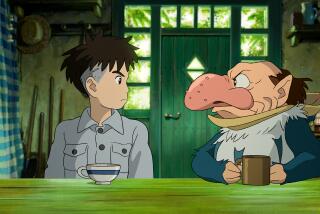‘Lupin III: The Castle of Cagliostro’ is a must-see zippy adventure for Miyazaki fans
- Share via
Midway through “Lupin III: The Castle of Cagliostro,” the titular thief laments on the magical feats he’d be able to accomplish if only a certain someone would believe in him.
But this Lupin III has pulled off something more impressive than flying through the air or swallowing all the water in a lake — he’s remained one of the most well-known and memorable incarnations of the beloved character for over 40 years. The feature directorial debut of animation’s great Hayao Miyazaki, “The Castle of Cagliostro” (1979) is now considered an anime classic and an all-new 4K restoration is hitting U.S. theaters for a limited release.
The action-packed heist film, co-written by Miyazaki and Haruya Yamazaki, opens with Lupin III and his partner Daisuke Jigen zipping away from a successful job robbing a major casino, only to discover that their mountain of cash is all high-quality counterfeit bills. So Lupin and Jigen set their sights on the tiny nation of Cagliostro, the rumored origin of these counterfeits.
Lupin III’s first 3DCG feature is a fun, zippy adventure where the gentleman thief and his friends triumph against Nazis.
It’s not long until the partners in crime get wrapped up in a larger plot. Upon noticing that a young woman speeding by in a car is being pursued by a group of suspicious men, Lupin and Jigen join the spectacular, gravity-defying car chase — just one of many memorable action sequences. It turns out this young woman, Clarisse, is Cagliostro’s beloved princess and her cousin, the sinister Count, is forcing her to marry him so he can try to find the fabled hidden treasure of Cagliostro.
Joining Lupin in this adventure besides the sharpshooter Jigen is their ally, the swordsman Goemon. Other franchise regulars such as Fujiko Mine, a fellow thief and sometimes friendly rival, as well as Inspector Zenigata also get in on the action.
The charm of Miyazaki’s Lupin is that he is ultimately a master thief with principles — more of a James Bond-Robin Hood hybrid than other incarnations of the character. And you can’t help but believe that he’ll both pull off some unimaginable feat and do what’s right at the end.
Created by Japanese artist Monkey Punch for his serialized manga series that launched in 1967, Lupin III is the grandson of French novelist Maurice Leblanc’s fictional gentlemen thief Arsène Lupin. The long-running franchise has grown to include a number of TV series, spinoffs and films (including the 2019 feature “Lupin III: The First”), and the original Lupin III is a bit more of a ruthless criminal.
HBO Max launched with all but one Studio Ghibli movie in its library. This is the best order to watch them.
But Miyazaki, who previously worked on episodes of the “Lupin III” TV series along with fellow eventual Studio Ghibli co-founder Isao Takahata, has imprinted “The Castle of Cagliostro” with his artistic sensibilities. Besides depicting a more gallant hero, the film includes beautifully painted backdrops from nature and impressive architecture.
“The Castle of Cagliostro” is thematically slim compared to some of Miyazaki’s later works, but it’s still a fun and visually stunning adventure that rebukes both personal greed and political corruption. That Clarisse is more a straightforward damsel in distress is a bit disappointing, but within her are glimpses of the independence that have come to define many of Miyazaki’s girl protagonists. That Fujiko in “The Castle of Cagliostro” is depicted as a capable spy and thief operating on her own also helps.
Particularly for those who have come to appreciate Miyazaki’s better-known works, “The Castle of Cagliostro” is a must-see.
'Lupin III: The Castle of Cagliostro'
In both Japanese with subtitled English and dubbed English versions
Not rated
Running time: 1 hour, 42 minutes
Playing: Landmark Westwood
More to Read
Only good movies
Get the Indie Focus newsletter, Mark Olsen's weekly guide to the world of cinema.
You may occasionally receive promotional content from the Los Angeles Times.











